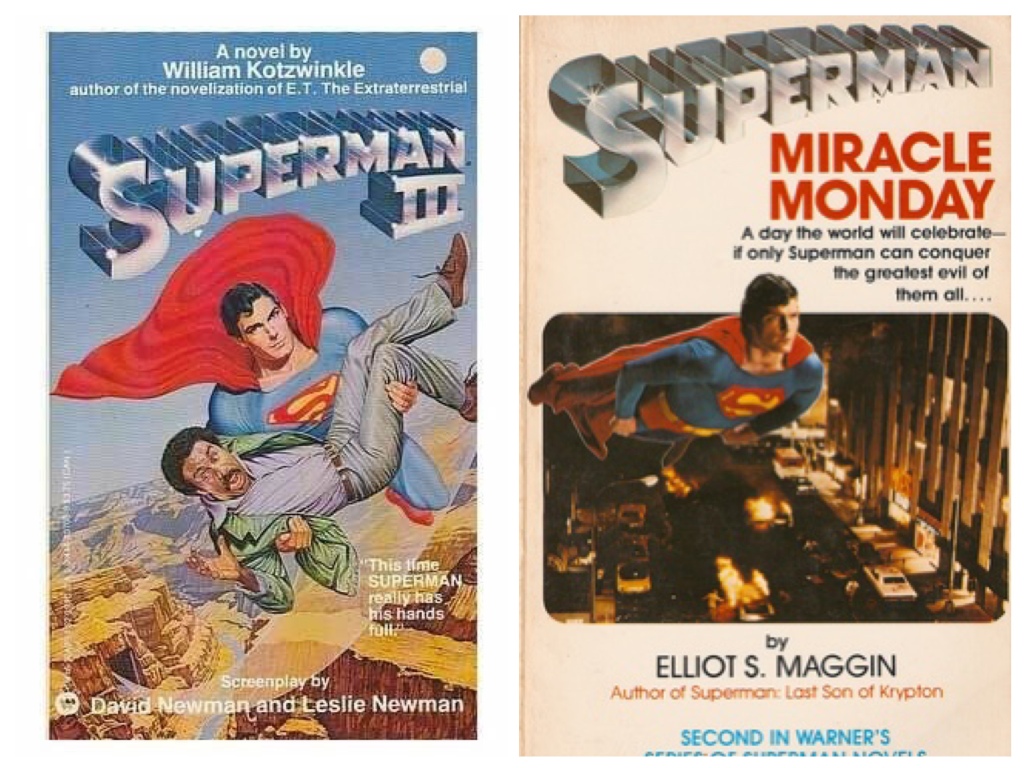
Novelizations and Adaptations – Part 2
Yesterday I discussed the complexities in bringing adaptations of Superman: The Movie to print and how DC Comics and Warner Bros. were essentially hamstrung in presenting any printed version of the film to the public because of certain contractual issues from the film’s original screenwriter, Mario Puzo. To that end original stories were told, behind the scenes looks were presented, and slight Easter eggs were cleverly hidden in the comics and animated series of the time.
Now let’s turn our attention to the 1980s and what the three follow-up Superman sequels would present in terms of novelizations and adaptations.
By the time the end credits of Superman: The Movie rolled, the final credit promised that Superman II would arrive “next year”. At the time of the film’s release, the general public was not aware of the behind the scenes drama that involved Puzo, Marlon Brando, Alexander and Ilya Salkind, Pierre Spengler, and Richard Donner. Once March 1979 rolled around, Donner was out, and the Salkinds brought in Richard Lester to oversee rewrites and reshoots for the film. The final result was a mixture of Lester footage that not only filled in certain holes in the story but also replaced many of Donner’s original, and in some cases far superior, footage. Fans didn’t seem to mind at the time, as the final film was released in theaters in December 1980 in Australia, April 1981 in the United Kingdom, and June 1981 in the United States, among others, to rousing success.
By the time of the US release of Superman II, Warner Books’ print marketing campaign was greatly reduced. As opposed to the generous print publicity campaign that expanded awareness of the first film in 1978, things were greatly minimized. There would be no “Making of Superman II” book released (although a TV documentary covering a few of the production aspects of Richard Lester’s tenure were covered, no mention was made of the drama between Donner and the Salkinds, though Donner and Gene Hackman were featured in archival footage, and a brief mention of new footage matching the footage from three years prior). And thanks to the clause in Puzo’s contract, there was no print novelization of the film.
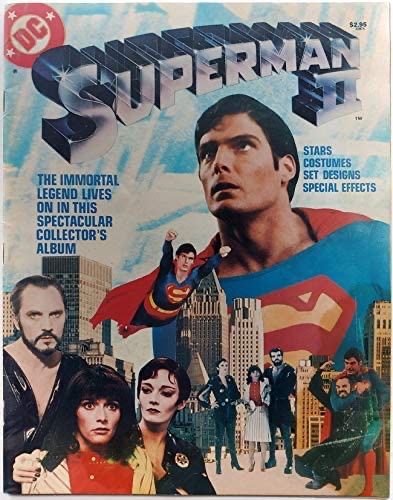
Elliot S. Maggin, who wrote the original novel Last Son of Krypton, returned to write a follow-up sequel entitled Superman: Miracle Monday, an original novel that was released in late May 1981 shortly before the film’s US release. This original story spotlighted Superman’s battle against C.W. Saturn, an agent of the Devil, and his exposure of his dual identity to the world. Meanwhile, a time traveler named Kristin Wells, a future descendant of photographer Jimmy Olsen, arrives from the 29th century to investigate the origins of a futuristic holiday known as Miracle Monday, only to discover that Superman’s wish for all of the chaos in the world to be reversed, and the lingering memories of the events that had unfolded, would exist in people’s minds and hearts, thereby beginning the holiday that would be known as Miracle Monday. The novel, while different from the film, would contain an eight-page photo album of scenes from Superman II.
In retrospect, this novel does contain some similarities to what would later be featured in Superman II: The Richard Donner Cut in 2006, with Superman turning back time to undo the damage to the world, as well as the growing romance between him and Lois Lane, which was also heavily featured in the novel, particularly in one scene where the Man of Steel creates his own customized Arctic jacuzzi for him and Lois to enjoy a very romantic dinner together. And if you think the similarities between book and novel end there, further similarities can be found in the first of the Fantastic Four two-film series, where Chris Evans’ character of Johnny Storm inadvertently creates a snow-frozen jacuzzi for himself and a romantic date, while the 2021 film Spider-Man: No Way Home features Peter Parker seeking Doctor Stephen Strange’s help in reversing time so no one remembers that he and Spider-Man are one and the same. Interesting tips of the hat indeed!
But the novel would not mark Kristin Wells’ final appearance. She would later return in the second DC Comics Presents annual “The Superwoman of Metropolis”, where she returns to investigate the origins of the mysterious superhero named Superwoman. Eventually she aided Superman in defeating the villainous King Kosmos and learned that through the use of clever costuming and use of futuristic technology she was, in fact, Superwoman.
And yet the first DC Comics Presents annual “Crisis on Three Earths” could also be considered an illustrated prequel to the events of Superman II. In that story, the Superman of Earth-1 teams up with the Superman of Earth-2 to fight off a dual threat from both worlds’ versions of Lex Luthor. One of the running subplots is the younger Superman seeking advice from his older counterpart about how to win Lois’ heart, something we see him wrestling with in the film about how he wants Lois to notice him for him, not just as Superman, and not just as the bumbling Clark Kent with a lack of self-confidence. The last panels of the story see Superman returning to Metropolis from his adventure, ready to talk with Lois and confess his feelings, but he misses her ever so slightly, as Perry White sends her to Europe on an impromptu and important assignment (presumably the hydrogen bomb in Paris – at least that’s what I thought). While this particular comic book story is not a direct prequel per se, the connections to the film are quite interesting indeed.
Two years later, Superman III arrived in theaters in June 1983, again directed by Richard Lester and featuring Richard Pryor as a bumbling computer genius who gets hooked up with a shady businessman to overthrow the world’s natural resources and build a giant super computer to go up against Superman. The film is mainly remembered for its awkward mixture of comedy and adventure, although standout moments include Superman preventing a fire at a chemical factory from going awry, and a Jekyll versus Hyde junkyard battle between Clark Kent and an evil Superman.
This time around, freed from the clause of Mario Puzo’s contract, DC Comics and Warner Books were free to pursue adaptations of the film, the first in the Superman film series to do so. The 64-page comic, adapted by Cary Bates from the script by David and Leslie Newman, with artwork by Curt Swan and Sal Amendola, handled the film’s story fairly well while removing the references to alcohol and tobacco usage, given the standards of the Comics Code Authority at the time. The awkwardness of the film’s humor was also removed from the comic, presenting the story in a straightforward manner.
But it was the portrayal of Superman that stands out in this adaptation. During the development of the comic, Christopher Reeve asked Curt Swan to specifically draw the character to resemble him. This is interesting, because in those early publicity photos from Superman: The Movie, fans remarked how much Reeve looked like a Curt Swan illustration come to life. So in a sense that circle was now complete. But it wouldn’t be the last time we would see Gus Gorman or the adult Lana Lang (Annette O’Toole) in the comics. Both would make clever cameo appearances in the recent Superman ‘78 series by writer Robert Venditti and artist Wilfredo Torres, which was set before the events of Superman III.
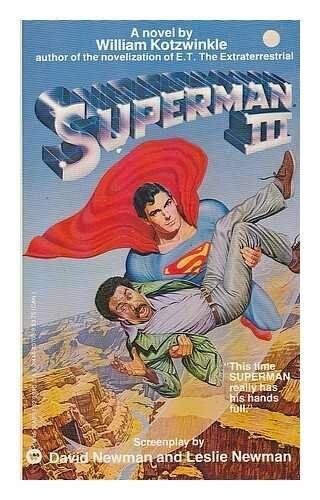
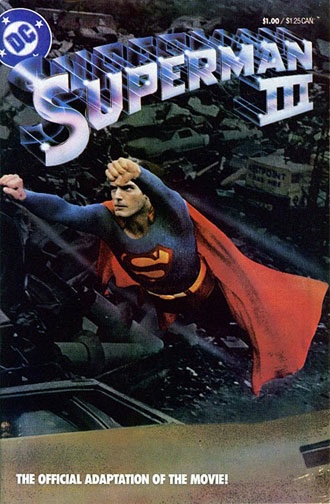
Warner Books was also able to present a novelization of the film, written by William Kotzwinkle. Kotzwinkle was known at the time for his adaptation of E.T. The Extra-Terrestrial a year earlier in 1982, as well as for that film’s original sequel novel E.T.: The Book of the Green Planet, among his many works. His adaptation of Superman III fleshes out the story and contains more of the characters’ inner monologues, interactions, and thoughts than were shown in the film, along with brief added moments that would not be seen until the TV broadcast of the extended version. Kotzwinkle also includes a couple of extra moments involving Lois Lane that were not featured in the film, giving her more to do. For a film that has been criticized by some because of the awkward humor, the novelization improves a bit upon the story. And as with the previous novelizations, there is a 16-page album of photos from the film.
This time around, however, DC did not produce a collector’s magazine on the making of the film. That honor fell to Starlog Press, which produced a 64-page poster magazine that year. It was their first foray into a collector’s magazine devoted to the Superman films, and while it briefly touched upon the first two films, their primary focus was on Superman III, with ten posters included in the magazine. As with the two previous magazines from DC, I found myself picking up this magazine at one of the local bookstores in town. Through my senior year of high school, it would be one of my go-to films that year (along with the third Star Wars film Return of the Jedi).
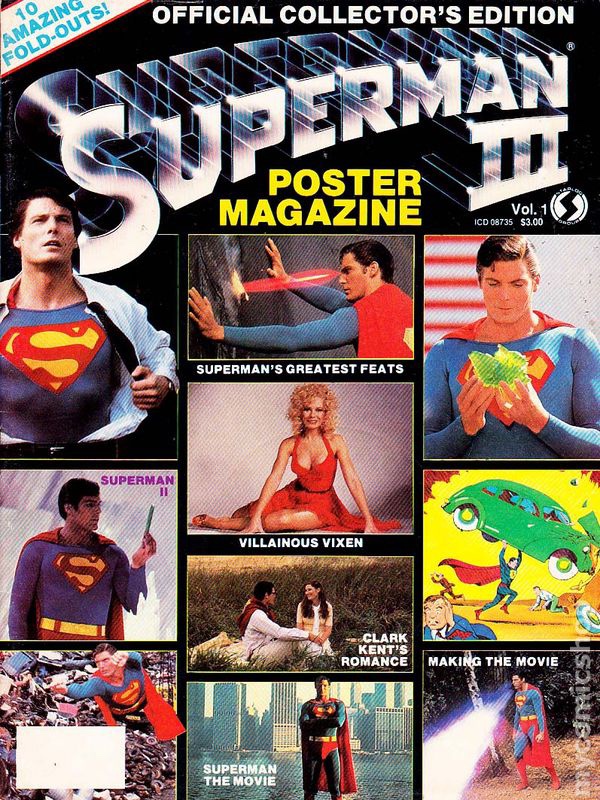
Four years later saw the release of the fourth film in the series, Superman IV: The Quest for Peace. As opposed to the success of the first two movies and the moderate success of the third movie, the fourth film was an overall critical and commercial failure, despite the best of intentions to return to the heart and spirit of the first film and the abrupt reduction of the film’s budget to a rather minuscule amount. The final result was the quality of a TV movie of the week, and after its truncated 89 minutes, it left me asking, “That’s it?” But that’s a story for another time.
Once again we were given novelizations to the film, along with an illustrated adaptation from DC Comics and a poster magazine from Starlog Press. This time, however, there would be not one but two different novelizations of Superman IV, not from Warner Books but from a most unlikely publisher: Scholastic Books. If you’re of a certain age like me, you most likely remember coming home from school with a flyer from Scholastic Books of different books and magazines for mere pennies on the dollar, and getting armloads of books as a result. So the selection of Scholastic Books as the publisher of the Superman IV novel seemed rather unusual at the time. If I hadn’t found it at the bookstore, I probably wouldn’t have known about it at the time.
As opposed to the first two original novels and the more in-depth adaptation of the third movie, this adaptation felt extremely brief and uninspired. Adapted by Bonnie Bryant (B.B.) Hiller from the story by Christopher Reeve, Lawrence Konner, and Mark Rosenthal, the novel ran 144 pages in length and was geared toward readers on a third and fourth grade level. Each chapter is unusually short, and the novel is relatively straightforward from the film’s script, which was the basis for the original 134-minute cut of the film. And the book contained eight pages of photos from the film. Scholastic Press also published an even briefer photo album of scenes from the film, adapted by Nancy E. Krulik. I’ve never seen this photo book, and it’s only been in the past few years that I learned that it was even produced in the first place.
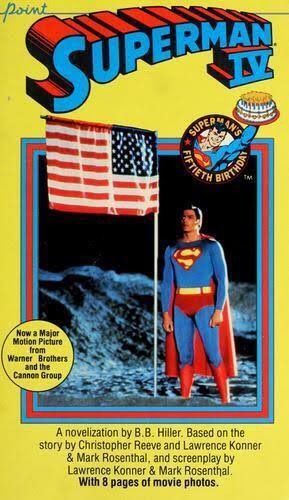
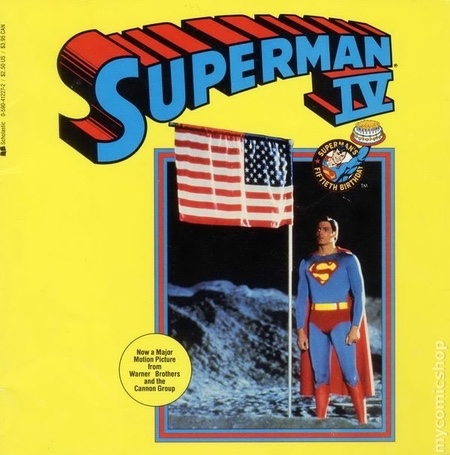
DC Comics also produced a 48-page comic book adaptation of Superman IV, adapted by writer Bob Rozakis, with artwork by Curt Swan, Don Heck, and Frank McLaughlin. While Swan’s artwork was as good as always, Don Heck’s artwork in the middle of the comic seemed hastily produced. The adaptation is best remembered for the inclusion of many of the scenes that were edited from the original 134-minute cut of the film, including the creation of the first Nuclear Man and the complete Metro Club sequence, among others. And recently, the character of Nuclear Man made his debut in the Superman comics for the first time since his appearance in the film.
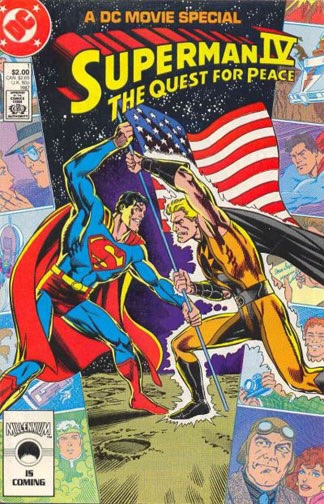
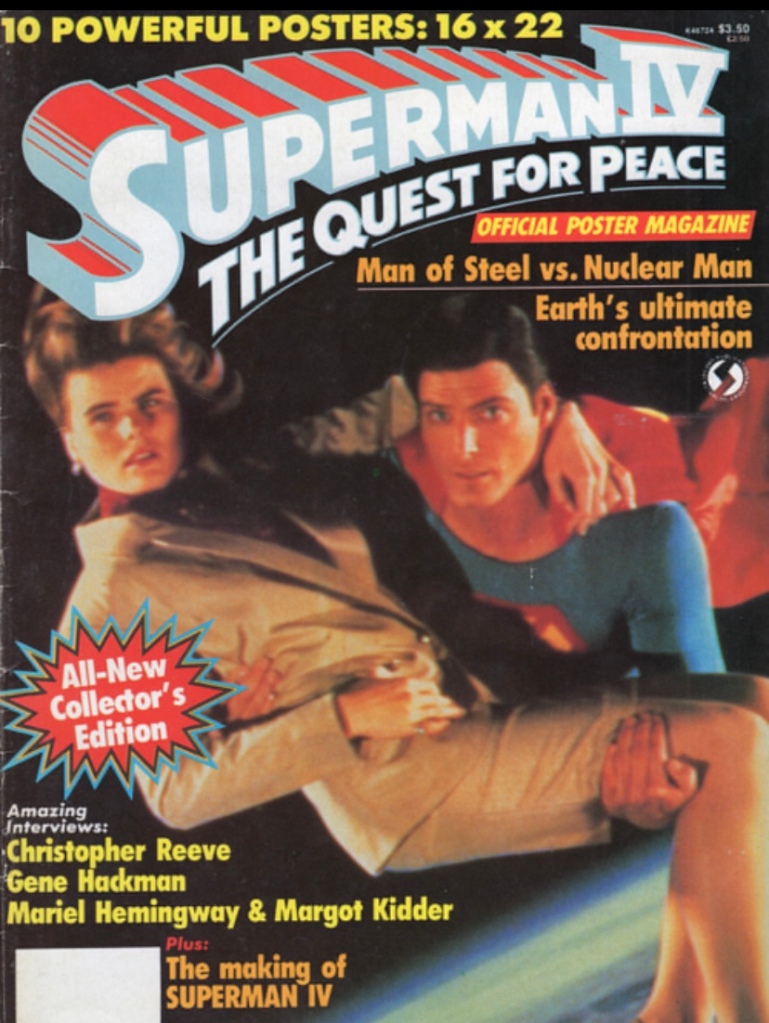
Starlog Press also produced a poster magazine based on Superman IV. I should have picked this one up, but I never did. This magazine contained numerous photos and posters from the film, including many of the scenes cut from the film. All of these resources helped fill in the gaps that were made in the editing process of the film until the release of many of the deleted scenes on the 2006 DVD.
With the numerous novelizations, original novels, comic books, poster magazines, and film magazines that were produced among the release of the four films, all of them contributed numerous aspects that further expanded the Superman film series, and all of them continue to this day to be sought after by Superman fans and collectors everywhere.
- Update on the New Supergirl Blu-rayRecently I published my latest blog on the release of the new Supergirl Blu-ray import from Germany (and also Austria), and as soon as it dropped, comments came out of… Read more: Update on the New Supergirl Blu-ray
- A Look at the New “Supergirl” Blu-rayIt seems like it’s been a lot more than 40 years since the Supergirl spinoff film was released in theaters, but it’s not. It was 1984 that saw the release… Read more: A Look at the New “Supergirl” Blu-ray
• • •